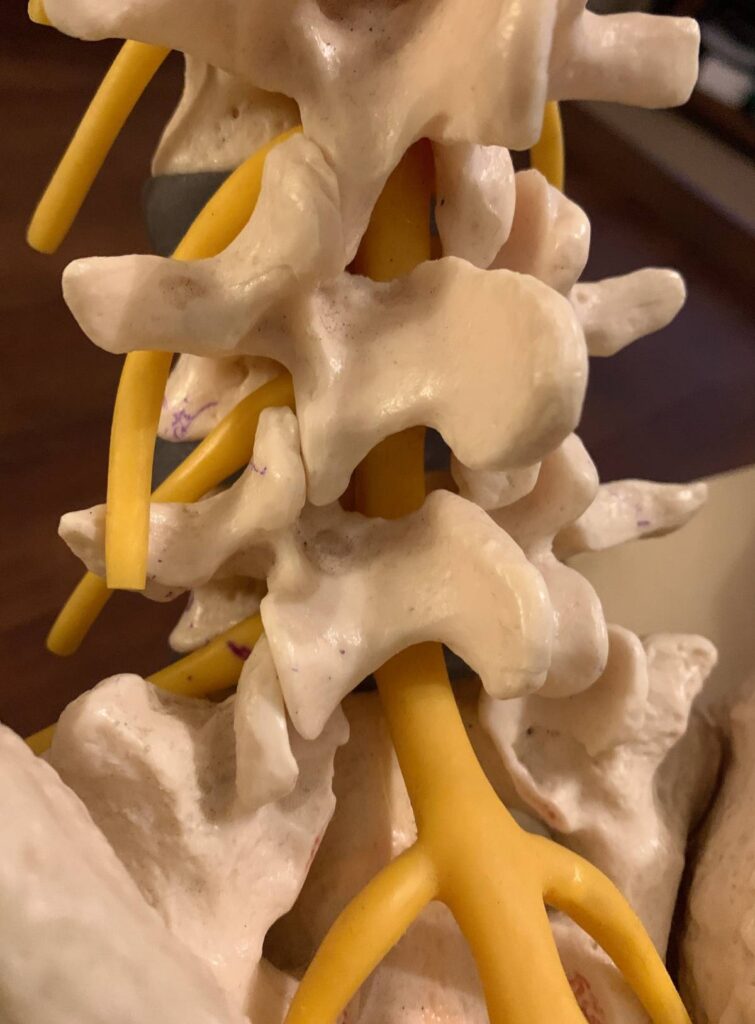lumbar facet joint pain
The spine consists of vertebrae stacked on top of each other, connected by pairs of joints called facet joints, discs and complex array of ligaments.
These joint surfaces are coated with cartilage, and surrounded by a connective tissue capsule, with synovial fluid to promote easy gliding of surfaces.
There are a ‘micro movements’ that can take place in the facet joints, bending forward and backward, side to side, and twisting.
The lumbar spine is designed to support the weight of the body when standing. This in turn makes it susceptible to developing injury or strain. The facet joints in the lumbar region have a rich network of nerves, which makes them more prone to irritation or pain.
Often nerve impingement in this area leads to numbness and/or pain in one or both legs, which can happen in Sciatica.
What causes lumbar facet joint pain?
Lumbar facet joint pain is commonly caused by several factors including degeneration and trauma.
Overuse of any joint over many years can cause it to become Degenerated and Arthritic.
This is because the constant friction between joints causes wear and tear not only of the cartilage, but also of the bone and the capsule.
Certain activities or occupations requiring people to overload their facet joints may result in lumbar facet joint pain to become a chronic issue.
Which activities overload the facet joints?
Standing with a hyperextended back, twisting movements or lifting heavy loads with weak back muscles can transfer the load to the facet joints and result in earlier degeneration.
Disc herniation can also cause premature facet joint pain as the facet joints ‘rub’ against each other more as the space between them reduces when we have a situation of disc herniation
Sometimes, simply poor posture is to blame, which adds unnecessary stress to the lower back.
Obesity also puts people at risk for developing such pain and age-related degeneration of the joints is also a factor.
Direct trauma to the spine can also lead to pain in the lumbar facet joints.
This can occur in a road traffic accident, an athletic injury, or any other form of forceful impact that can cause damage to the joints and their surrounding nerves.

Diagnosis of Lumbar Facet Joint Pain
Patient History:
Medical Exam:
- A visual inspection of the posture and the skin overlying the spine in the affected area.
- Palpation of the spine to check for tender areas and muscle spasms
- Motion tests to check the range of mobility of the joints
- Checking each spinal segment of the involved joints
- Neurological tests to determine muscle strength, reflexes, and skin sensation
Tests: Before diagnosing, the doctor wants to make sure that there are no other serious issues, for example a cancerous growth, an infection, or a fracture.

For this reason, certain diagnostic scans are done after examination, including
- XRAYS - To look for Bony changes or Degeneration within the joint.
- COMPUTED TOMOGRAPHY - provides more information than x-rays regarding the bones and to rule out sinister pathology
- MRI - to assess the soft tissues of the spine, such as the discs and the nerve roots, and to determine whether it is an acute or chronic issue. Moreover, it can also show the degree of facet joint degeneration or nerve entrapment
Apart from the above tests, the other reliable investigation is a diagnostic facet joint block.
A Local Anaesthetic (numbing medication) is injected into the facet joint to see if the pain decreases significantly or stops for a few hours.
If it does the lumbar facet joint is thought to be the pin generator and w can proceed with further injections to treat the joint.
This an indicator that the pain is arising from the lumbar facet joints.
Treating Lumbar Facet Joint Pain
Lumbar facet joint pain can impact day-to-day activities and adversely affect a persons life.
Prolonged standing, sitting and driving or a period of inactivity can worsen the situation.
Non-Surgical treatment options for Lumbar Facet Joint Pain:
To start with, doctors often opt for a conservative management approach.
Your doctor may advise you the following:
- Getting adequate amounts of rest, and reducing activity for a while
- Maintaining a correct posture
- Some over-the-counter pain medication, such as Ibuprofen
- Spinal brace to stabilize the spine, and reduce micro movements between the facet joints
- Physiotherapy to increase core muscle strength
- Exercises that are targeted for the lower back, to strengthen the core
- Cortisone injections given at the facet joints help relieve the pain
- Prolotherapy around the joints or ligaments
- Spinal Injections or Radiofrequency Nerve Ablation
Surgical treatment options for Lumbar Facet Joint Pain:
Surgical treatments are pursued when the other methods are unsuccessful.
Facet joint degeneration is often irreversible, but surgery can reduce pain and inflammation, nerve damage, pressure on the spine, and improve the overall quality of life.
Depending on your condition, the neurosurgeon may recommend one of the following surgical procedures
- Lumbar Spinal Fusion - a minimally invasive procedure in which the lumbar vertebrae are fused together to eliminate the movement between them
- Facetectomy - If there is severe arthritis in the facet joints, a surgeon performs facetectomy to remove the excess bone, thus alleviating nerve and spinal impingement
Lumbar facet joint pain may not always be fully treated, but it is quite manageable with certain lifestyle changes, exercises and procedures
People can lead pain-free and comfortable lives, if they seek treatment early.
Contact us
We’d love to hear from you!
Just reach out and contact us via any of
these channels:

Call us on

Email us on

Call us on





